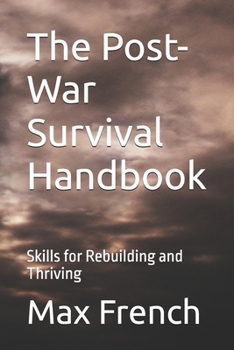The Post-War Survival Handbook: Skills for Rebuilding and Thriving
Chapter 1: Introduction to Post-War Survival
In the aftermath of war, understanding the complexities of survival becomes paramount. Key skills include:
Self-Sustainability: Individuals must cultivate food foraging, preservation, and urban agriculture to combat scarce resources.
Water Sourcing & Purification: Mastering techniques for sourcing and purifying water is vital to prevent health crises.
Shelter Building: The ability to construct shelters from available materials provides protection against the elements.
Resourcefulness & Bartering: With traditional currency losing value, cultivating creativity in resource utilization and bartering goods becomes crucial.
The importance of these skills transcends practical knowledge, laying the groundwork for community resilience and support.
Chapter 2: Urban Survival Techniques
Navigating urban environments post-war requires specific strategies:
Assessing Environments: Recognizing local infrastructure, resources, and potential threats is key to effective planning.
Safe Navigation: Developing skills in map reading and situational awareness ensures personal safety.
Finding Resources: Knowing how to forage in urban settings and utilize community networks can secure essential supplies.
Ultimately, successful urban survival hinges on adaptability and collaboration.
Chapter 3: Wilderness Survival Skills
Wilderness skills complement urban techniques and include:
Identifying Edible Plants: Knowledge of local flora for food sourcing is essential.
Basic Gear: Essential equipment like portable water filters, fire starters, and first aid kits are vital for survival.
Natural Hazards: Learning to recognize and respond to natural hazards enhances safety in wild environments.
These skills empower individuals and families to thrive regardless of their setting.
Chapter 4: Food Foraging and Preservation
Food security establishes the foundation for survival, requiring:
Foraging Techniques: Learning to identify and harvest edible plants and fungi can provide vital nutrition.
Preservation Methods: Techniques like dehydration, canning, and freezing extend food shelf life.
Sustainable food sourcing and preservation strategies foster community resilience.
Chapter 5: Self-Defense and Personal Safety
Key self-defense skills enhance safety:
Basic Techniques: Mastering fundamental self-defense moves helps protect against threats.
Situational Awareness: Being vigilant and reading body language can prevent confrontations.
Building a culture of safety within families and communities is crucial for shared well-being.
Chapter 6: Water Purification and Sourcing
Understanding water management ensures access to clean water through:
Sourcing Techniques: Identifying natural water sources and their purification methods is essential for survival.
Storage Solutions: Knowledge of proper water storage techniques is necessary to maintain supply.
Sustainable water management practices bolster community resilience.
And many more...




